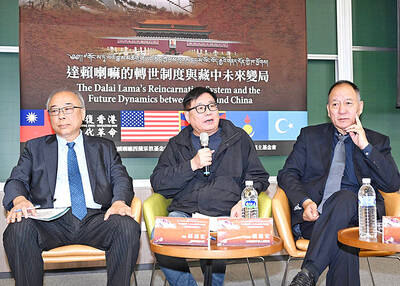Lieutenant General Michael Maples, the US Defense Intelligence Agency director, on Wednesday confirmed that China has deployed more than 1,000 ballistic missiles against Taiwan and developed more powerful missiles, with the range to reach all the facilities of the US and its allies in the region. He also said that Beijing may be seeking to operate an aircraft carrier.
In his report, entitled Current and Projected National Threats to the United States, to the Senate Committee on Armed Services, Maples said that China had bought four Russian-built S-300 PMU-2 air defense battalions and intended to buy four more. "This increases its engagement range out to 200km," he said.
"China is developing a layered maritime capacity with medium-range anti-ship ballistic missiles, submarines, maritime strike aircraft and surface combatants armed with increasingly sophisticated anti-ship cruise missiles," he said.
He added that the Chinese People's Liberation Army (PLA) has already achieved "moderate success," and additional integration may accelerate as the PLA explores the full potential of such weapons.
"China is looking beyond a potential Taiwan contingency and is pursuing capabilities needed to become a major regional power. The navy already operates a large surface and an increasingly modern submarine fleet and may be seeking to operate an aircraft carrier," he said.
"Although China may not achieve a true regional power-projection capability in the next decade, it most likely will increase maritime patrols of disputed oil fields and its Exclusive Economic Zone," he said.
According to Maples, China's space and counterspace capabilities have "significant implications" for US space-based communications, intelligence, surveillance and reconnaissance operations in a Taiwan Strait contingency and beyond.
"Citing its manned and lunar space programs, China is improving its ability to track and identify satellites -- a prerequisite for anti-satellite attacks," he said.

ALIGNED THINKING: Taiwan and Japan have a mutual interest in trade, culture and engineering, and can work together for stability, Cho Jung-tai said Taiwan and Japan are two like-minded countries willing to work together to form a “safety barrier” in the Indo-Pacific region, Premier Cho Jung-tai (卓榮泰) yesterday said at the opening ceremony of the 35th Taiwan-Japan Modern Engineering and Technology Symposium in Taipei. Taiwan and Japan are close geographically and closer emotionally, he added. Citing the overflowing of a barrier lake in the Mataian River (馬太鞍溪) in September, Cho said the submersible water level sensors given by Japan during the disaster helped Taiwan monitor the lake’s water levels more accurately. Japan also provided a lot of vaccines early in the outbreak of the COVID-19 pandemic,

Kaohsiung Mayor Chen Chi-mai (陳其邁) on Monday announced light shows and themed traffic lights to welcome fans of South Korean pop group Twice to the port city. The group is to play Kaohsiung on Saturday as part of its “This Is For” world tour. It would be the group’s first performance in Taiwan since its debut 10 years ago. The all-female group consists of five South Koreans, three Japanese and Tainan’s Chou Tzu-yu (周子瑜), the first Taiwan-born and raised member of a South Korean girl group. To promote the group’s arrival, the city has been holding a series of events, including a pop-up

TEMPORAL/SPIRITUAL: Beijing’s claim that the next Buddhist leader must come from China is a heavy-handed political maneuver that will fall flat-faced, experts said China’s requirement that the Dalai Lama’s reincarnation to be born in China and approved by Beijing has drawn criticism, with experts at a forum in Taipei yesterday saying that if Beijing were to put forth its own Dalai Lama, the person would not be recognized by the Tibetan Buddhist community. The experts made a remarks at the two-day forum hosted by the Tibet Religious Foundation of His Holiness the Dalai Lama titled: “The Snow Land Forum: Finding Common Ground on Tibet.” China says it has the right to determine the Dalai Lama’s reincarnation, as it claims sovereignty over Tibet since ancient times,

Temperatures in some parts of Taiwan are expected to fall sharply to lows of 15°C later this week as seasonal northeasterly winds strengthen, the Central Weather Administration (CWA) said today. It is to be the strongest cold wave to affect northern Taiwan this autumn, while Chiayi County in the southwest and some parts of central Taiwan are likely to also see lower temperatures due to radiational cooling, which occurs under conditions of clear skies, light winds and dry weather, the CWA said. Across Taiwan, temperatures are to fall gradually this week, dropping to 15°C to 16°C in the early hours of Wednesday